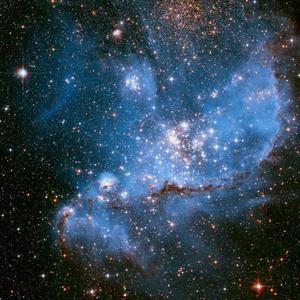
PUMPA - SMART LEARNING
எங்கள் ஆசிரியர்களுடன் 1-ஆன்-1 ஆலோசனை நேரத்தைப் பெறுங்கள். டாப்பர் ஆவதற்கு நாங்கள் பயிற்சி அளிப்போம்
Book Free DemoClouds of gases began to compress under gravity shortly after the Big Bang, forming the basic building blocks of galaxies.
A galaxy is a large collection of stars and celestial bodies held together by the force of gravitational attraction between them.

Different galaxies in the universe
Scientists estimate that the observable universe has one hundred billion (10^{11}) galaxies.
Types of galaxies:
Galaxies are in a variety of shapes and sizes. Based on their appearance, galaxies are classified into three types, namely,
- Spiral galaxy
- Elliptical galaxy
- Irregular galaxy
1. Spiral galaxy:
Spiral galaxies are bulged at the centre with old stars and surrounded by a flat, rotating disk of young stars.

Spiral galaxy
Milky Way galaxy:
The galaxy that we live in is the Milky Way galaxy, which is spiral in shape. From Earth, the Milky Way appears like a band of light in the night sky, hence got the description “Milky”. In Indian mythology, the Milky Way is also known as 'Akashganga'.

Milky Way Galaxy
Milky Way galaxy consists of approximately 100\ billion stars, and its diameter ranges around 1,00,000\ light\ years.
Important!
Our Sun takes 250\ million\ years to go around the centre of the Milky Way galaxy since the solar system is located 25,000\ light\ years away from the centre of the Milky Way.
2. Elliptical galaxy:
Elliptical galaxies are ellipsoidal in shape, and the stars are in random orbits around the centre. The stars located in the elliptical galaxies are much older than stars in spiral galaxies.

Elliptical galaxy
An example of the elliptical galaxy is Cygnus A which is located 600\ million\ light\ years away.
3. Irregular galaxy:
An irregular galaxy does not have any regular shape. It has neither a bulge nor a spiral arm structure.

Irregular galaxy
Canis Major dwarf galaxy is a good example of an irregular galaxy.
Important!
Do you know!
Around 25\% of the galaxies that have been discovered so far fall in this category.
Galaxies can be found alone or in pairs, although they are more frequently found as part of groups, clusters, and superclusters. Galaxies in groups interact with each other and merge.
Neighbouring galaxy:
Our nearest neighbouring galaxy is the Andromeda galaxy which is at a distance of 2.5\ million\ light\ years away. It will take 25\ billion\ years to reach the Andromeda galaxy if we travel at the speed of the Earth, which is 30\ km/s.
Reference:
https://upload.wikimedia.org/wikipedia/commons/e/e5/A_Sky_Full_of_Galaxies.jpg